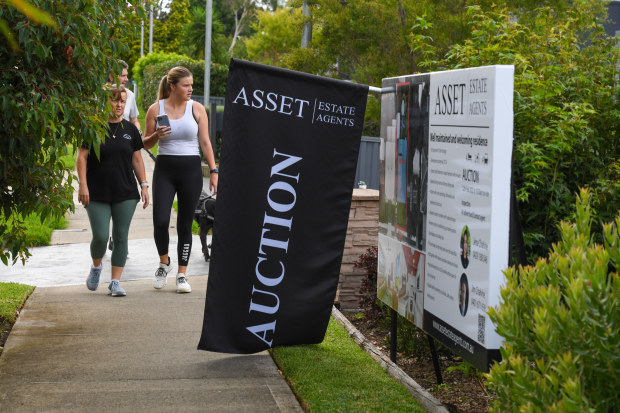
New listings for investor-owned residential properties have nearly doubled nationwide since December, as some landlords may look to offload assets to ease the pressure of the rapid interest rate rises.
More than 5000 investment properties were listed for sale in the past three months, lifting the nationwide tally to 10,542 data from CoreLogic shows.

Investor-owned listings have surged since December as some landlords started to feel the pain of rising interest rates. Peter Rae
Investor-owned listings account for 28.9 per cent of new stock on the market, a 1.9 percentage point rise from December.
Tim Lawless, CoreLogic research director, said the share of investor-owned listings was still lower than last year’s peak when it accounted for 35 per cent of all stock, but has climbed higher than the long-term trend.
“There is likely to be a growing number of investors facing cash flow challenges which could be prompting a decision to sell,” Mr Lawless said.
“Although rental income has risen amid record low vacancy rates in most areas, in most areas, the rise in rents hasn’t been enough to offset the rise in mortgage repayments.”
In Sydney, the volume of investor-owned listings has more than tripled to 2030, increasing their share by 2 percentage points to 33.8 per cent, the highest level since last July.
Across Melbourne, ex-rental listings have more than doubled to 2114 and in and the ACT, they have climbed to 219, while the other state capitals had listings increases of between 41 per cent and 80 per cent in the same period.
Some landlords who owned multiple rental properties were now struggling to meet their mortgage repayments, said Redom Syed, mortgage broker with Confidence Finance.
“We’ve been getting sell calls from our investor clients since late last year, and last month alone, we probably had half a dozen landlords telling us they are looking to sell because they were having difficulty paying their owner-occupier mortgage while also repaying their investment loans,” Mr Syed said.
“Most landlords are not desperate yet, but they are increasingly worried about their budgets, so they are looking to pay off some debts. Investors are not attached to their investment properties, so during a crunch, these assets are the first to go.”
Victor Kumar, Sydney-based investor and founder of buyer’s agency Right Property Group, said new investors were likely to struggle the most, particularly if they have not budgeted for those rate rises.
“Investors who bought in the past three years when rates were at record lows and spent their savings renovating and buying new cars, are likely to be most at risk of selling, if they have not saved enough buffer,” Mr Kumar said.

“I’m already starting to see some landlord distress. I’m also seeing anecdotal evidence that people are seriously thinking of selling, with agents telling me requests for appraisal have surged across the board.”
Uncertainties and fear of further interest rate rises could also be prompting investors to sell now before their conditions worsened, said Margaret Lomas, founder of Destiny Financial Solutions.
“As it can take more than three months to sell a property, those investors feeling the pinch are afraid that if they wait to list their properties, there will be fewer buyers as the rates rise,” Ms Lomas said.
“So far, most investors have been able to hang in there. But it is the doubt around just how far the rate rises will go which is fuelling sales now.”
Despite the sharp rise in rents, the impact of the 10 consecutive rate rises on mortgage costs would still leave most investors with a massive shortfall, Mr Lawless said.
In Sydney for example, rents have jumped 11.8 per cent in the past 12 months, adding an extra $315 each month in rental income. However, over the same period, an investor with a $500,000 mortgage on the average variable rate would pay about $835 extra each month on their investment loan – a $520 deficit.
“Investors with low debt levels would be in a prime position to benefit from higher rental returns, but the reality for a highly leveraged investor is the rise in the cost of debt is likely to be outweighing any additional income derived from higher rents,” Mr Lawless said.
“Investors with multiple properties are likely to be more heavily geared. For those with high debt levels it’s reasonable to assume the rapid and significant rise in the cost of debt would be creating significant cash flow challenges despite the strong rental conditions.
“[So] we could see a rise in motivated listings as more property owners find they can’t service their loan repayments.”
Mr Kumar said more investors were likely to consider selling once they realised how much money they were losing each month.
“I would expect to see more landlords offloading their investment properties around July or August after they’ve done their tax returns and realised how much their rental properties are costing them to hold,” Mr Kumar said.
“If you add the sharp fall in prices and difficulty in refinancing, that’s when we might see some panic selling.“
Bagikan Berita Ini














0 Response to "Investment properties on the chopping block as rates rise - The Australian Financial Review"
Post a Comment